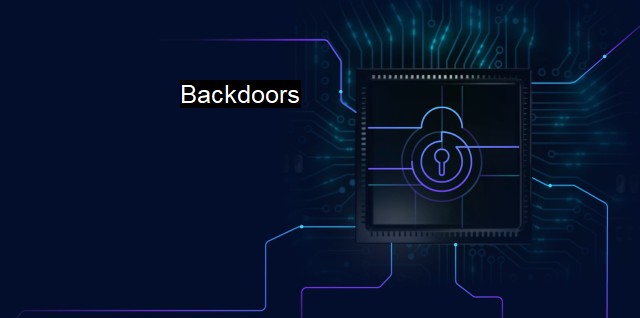What are Backdoors?
The Menace of Backdoors: A Looming Cybersecurity Threat
Backdoors are typically unseen and unknown entry points in a computer system or software that were purposely set up, often by the original developers, allowing them to gain access later, circumventing standard forms of security. Their presence within computer systems is a controversial topic as they may be exploited by this intended audience, but can also be used by malicious parties, once they are discovered.Like a hidden door within a house, backdoors allow individuals to secretly enter and navigate a location without being detected. In a similar manner, a backdoor in a computer system grants an individual undetected access, usually skipping the standard steps of authentication, encryption, and other measures that are implemented as part of a system's security. This undetected access can then be used for various aims depending on who controls it.
Generally, reputable software developers explicitly state if backdoors may or have been embedded within their software. There are a multitude of reasons to make use of backdoors, but primarily they are implemented for debugging programs during the development stages or for providing a legitimate way for system maintenance. As such, they can be an essential part of a company's operational procedures, allowing for smooth and efficient operation.
On the other hand, unethical programmers, likely with malicious intentions, can create backdoors without disclosing their existence. They may be sold to third-parties or used to gain unauthorized access to data or networks. Criminals can use backdoors for cybercrimes such as data breaches, stealing confidential information, or even for control of computer resources that can be used for illegal activities, such as hosting malware or executing denial-of-service attacks.
Due to this nefarious potential, backdoors are a chief concern for cybersecurity professionals. A single backdoor can expose a company to massive intellectual property theft or compromise sensitive customer data. with the rapid growth and reliance on digital networks, the implications of backdoors go beyond private corporations. Governments have been rumored to request backdoors into various software systems to allow for surveillance in the interest of national security.
This complex issue is multi-faceted because backdoors, while possibly aiding national security efforts, may also be exploited by ill-intentioned individuals or entities. Therefore, their potential to be misused has given rise to fierce debates about privacy and civil liberties.
In response, antivirus software has been programmed to detect backdoors and warn the user of their existence on the system. Their scan function looks for known trace signatures of backdoor codes throughout the system files and attempts to either eliminate or quarantine them to stop potential misuse, safeguarding the system.
To maintain a high level of protection, antivirus software needs to be updated frequently. Each update usually brings with it a list of the latest backdoors and other threats that the antivirus is now armed to fight against. Cybercriminals continually develop and deploy new backdoors, which are often designed to get unnoticed by antivirus software. A professional hacker can easily utilize unknown backdoors, also known as zero-day exploits, often to devastating effect.
While backdoors originally were implemented for benign purposes, they have become a serious concern in cybersecurity. Although powerful surveillance and crime fighting tools, they also pose potential threats to data and system integrity, privacy, and civil liberties. Navigating the careful balance between transparency, security, and privacy is a tremendous challenge. It requires thoughtful policy development, adept technological innovations, and vigilant antivirus and cybersecurity measures. Opportunities for misuse underline the need for ongoing vigilance, susceptibility assessments, and thorough threat response planning within the cybersecurity spectrum.

Backdoors FAQs
What is a backdoor in the context of cybersecurity?
A backdoor is a method of bypassing normal authentication procedures to gain unauthorized access to a computer system or network. It can be used by cybercriminals to steal sensitive information or install malware on a victim's computer.How do backdoors get installed on a computer system?
Backdoors can be installed through various methods, such as exploiting vulnerabilities in a system or network, tricking users into downloading or opening malicious files, or even being pre-installed in software by the manufacturer.How can I protect my computer system from backdoors?
To protect your computer system from backdoors, you can use antiviruses and firewalls. You should also keep your software up to date with the latest security patches, avoid downloading software or files from untrusted sources, and regularly backup your important data.What are some signs that my computer system may have a backdoor installed?
Some signs that your computer system may have a backdoor installed include unusual network activity, slow system performance, unexplained changes to your computer's settings or files, and the presence of unknown programs or services running on your computer. If you suspect a backdoor, it is advisable to run a full antivirus scan and contact a cybersecurity professional for further assistance.| | A | | | B | | | C | | | D | | | E | | | F | | | G | | | H | | | I | | | J | | | K | | | L | | | M | |
| | N | | | O | | | P | | | Q | | | R | | | S | | | T | | | U | | | V | | | W | | | X | | | Y | | | Z | |
| | 1 | | | 2 | | | 3 | | | 4 | | | 7 | | | 8 | | |||||||